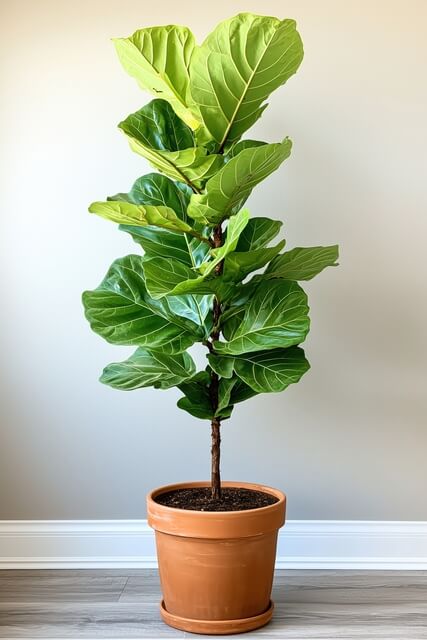Fiddle Leaf Fig
Ficus lyrata

The Fiddle Leaf Fig (Ficus lyrata) is one of the most iconic houseplants, cherished for its oversized, glossy green leaves shaped like a fiddle. Native to the tropical rainforests of West Africa, it brings a bold, architectural feel to modern interiors.
This plant thrives in bright, indirect light and prefers a consistent environment. While it can grow tall—often 6 feet or more indoors—it should be rotated regularly to maintain balanced growth. The Fiddle Leaf Fig can be sensitive to change, reacting poorly to drafts, inconsistent watering, or being moved frequently.
Though it requires a bit more attention than beginner plants, its dramatic look makes it worth the effort. With regular care, pruning, and leaf cleaning, this plant can become a striking statement piece in your space.
Quick Info
- Light: Bright
- Water: Medium
- Size: 5–10 feet indoors
- Humidity: Moderate
- Temp: 65–75°F
- Flowering: No
- Type: Tropical, Tree
- Dog Safe: No
- Cat Safe: No
- Kid Safe: No
Toxicity Info
- Dog Safe: No
- Cat Safe: No
- Kid Safe: No
Notes for Pets: Contains irritating sap; ingestion can cause oral irritation, vomiting, or drooling.
Notes for Kids: Not safe if ingested; sap may irritate skin or mouth.
Care Instructions
- Place in a spot with bright, indirect light—preferably near a large window.
- Water when the top 1–2 inches of soil feel dry. Avoid letting it sit in water.
- Rotate regularly to prevent the plant from leaning toward the light.
- Wipe dust off the leaves with a damp cloth to help with photosynthesis.
- Avoid drafts, sudden moves, or cold air which can cause leaf drop.
- Re-pot every 1–2 years as the plant grows to ensure healthy root space.
Common Problems
- Brown spots on leaves – Often caused by inconsistent watering or over-watering. Ensure soil drains well and avoid letting roots sit in water.
- Leaf drop – A common response to environmental stress such as low light, drafts, or being moved. Try to keep conditions stable.
- Curling leaves – May indicate under-watering or low humidity. Mist the plant occasionally and monitor moisture levels.
- Pale or faded leaves – Usually from too much direct sunlight or nutrient deficiency. Provide filtered light and consider light fertilization during growing season.
FAQs
This is often due to over-watering, inconsistent watering, low humidity, or sudden changes in light. Ensure your plant isn’t sitting in water, and try to keep lighting and moisture levels stable.
Fiddle Leaf Figs need bright, indirect light to thrive. They can tolerate some direct sun but too much can scorch the leaves.
Yes. Pruning encourages branching and a bushier shape. Cut just above a node (where a leaf was attached) using clean shears.
Yes, it’s toxic to cats and dogs if ingested. It’s best to keep it out of reach of pets.


